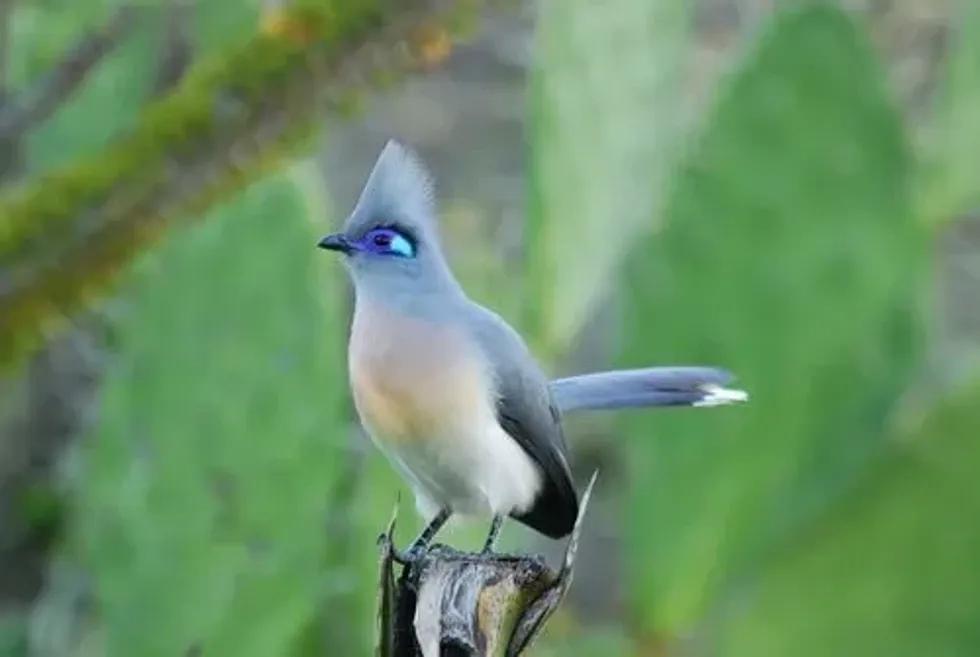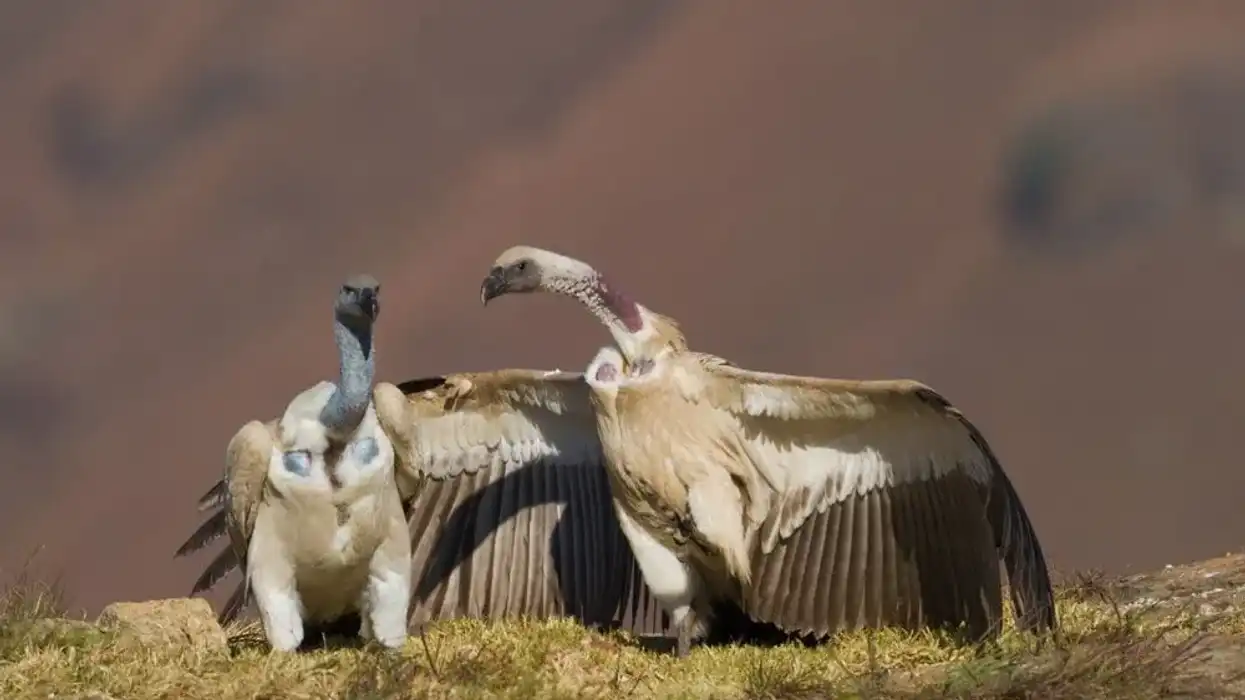Crested Coua (Coua cristata) is endemic to Madagascar and found in forests, shrublands, grasslands, and savanna in those areas. This bird species is found widespread throughout the large range of habitats in Madagascar and are abundant for now.
This species is frequently threatened by hunting practices and habitat degradation, but a large population of the bird is seen in many protected areas like national parks and sanctuaries, the species is currently not at a risk.
Crested Couas are medium-sized birds with a gray crest and long white-tipped purplish-blue tail feathers. They are easily recognizable and are quite beautiful. These birds are mainly terrestrial and arboreal and are not known much for flying. They use their long tail to balance while walking on the branches of the trees in the forest.
For more relatable content, check out these golden-hooded tanager facts and green hermit fun facts.
Crested Coua Interesting Facts
What type of animal is a crested coua?
Crested coua (Coua cristata) is a species of birds endemic to Madagascar.
What class of animal does a crested coua belong to?
Crested couas belong to the class of Aves in the kingdom of Animalia.
How many crested couas are there in the world?
The population of the crested couas is not known. They are known to have a range of an area of 562,000 sq km size.
Where does a crested coua live?
Crested couas are endemic to Madagascar. All four subspecies of the birds are found in North, West, East, and Southeast Madagascar.
What is a crested coua's habitat?
The crested coua habitat consists of forests, brushland, savannas, mangroves, and palms. The birds are mostly found in littoral and deciduous forests. They are found at an altitude up to 2952.76 feet (900 m) from sea level. However, usually, they are only seen in the forest up to a level of 2296.6 feet (700 m).
Who do crested couas live with?
The species is quite shy and often is seen solitary. During the breeding season, the species is found in pairs and outside the breeding season, they make small groups of three to five and mix with flocks of other birds.
How long does a crested coua live?
The crested coua lifespan in the wild is not known. In captivity, the lifespan of the bird is more than 15 years.
How do they reproduce?
The breeding season is from September to March. Nests are made of twigs and two white eggs are laid by females. Both parents are known to take part in incubating the eggs. After the eggs hatch, the chicks are usually naked with a reddish bill and dark skin. Young leaves the nest after 10 days.
What is their conservation status?
The conservation status of the crested coua (Coua cristata) is categorized as Least Concern by the IUCN Red List. Hunting for their meat has put the species in danger, but there is no immediate danger to them. Also, degradation of the habitats is a cause of the decrease in the population of the species.
Crested Coua Fun Facts
What do crested couas look like?
The upper parts of the crested coua (Coua cristata) are greenish-gray in color. The bird species has a gray head complemented with a conspicuous pointed crest. The chin and throat are colored gray.
The breast is colored rufous or plate orange, while the belly is white in color. The bare skin seen mainly around the eye is lilac with black outlines. Behind the eye, the skin is colored bright turquoise.
The eyes are mainly reddish-brown in color. The bill and legs are black.
The third toe of the bird can be reversed for better grip while walking on the trees in the forest. The highlight feature of this species is long purplish-blue tail feathers with white tips. Male crested coua size is similar to the female species.
Juveniles of the crested couas have rufous edged feathers and gray crests. The bills are pale with a pink base.
How cute are they?
They are very cute with vibrant different types of colors in the body.
How do they communicate?
Crested couas communicate by voice. A loud, descending “guay-guay-guay-guay-gwuck” sound can be heard from the forests when they sing together in a group.
How big is a crested coua?
Crested coua (Coua cristata) has a range of length from 15.7-17.3 in (39.8-44 cm).
How fast can a crested coua fly?
These birds are not usually known for flying. The speed is not known.
They only fly from the ground to the trees and from trees to the ground when needed in the forest.
How much does a crested coua weigh?
Crested couas weigh around 0.22-0.23 lb (99.7-104.3 g).
What are the male and female names of the species?
Male and female of the Crested coua (Coua cristata) are not given different names.
What would you call a baby crested coua?
Baby crested couas are called chicks.
What do they eat?
The diet of the medium-sized crested couas consists of fruits, berries, seeds, chameleons, different species of insects, and snails. Reptiles such as mice are also added to the diet of the crested couas. They feed on everything the forest offers.
The bird moves from tree to tree while foraging in the forest of Madagascar, by gliding.
In captivity, these birds should have a diet of a range of soft fruits and greens, insects, pinky mice.
Are they dangerous?
They are not dangerous.
Would they make a good pet?
This species is usually not considered a pet. They are not usually kept in zoos too.
Did you know...
These birds are not considered predators. They forage on everything the forest provides. Crested coua (Coua cristata) are known to feed primarily on insects, fruits, berries, seeds, snails.
Crested coua is not known for its flying. The bird usually bounces from tree to tree and does not fly.
In the wild, these birds are hunted for their tasty meat by humans. Also, fossa and birds of prey like hawks and eagles kill these crested birds for food.
Why is it called crested coua?
Crested coua (Coua cristata) name is given to the species because of their conspicuous pointed crest on the head.
Is crested coua endemic?
Crested coua is endemic to Madagascar. The bird species are found in the forests, brushland, and savanna of Madagascar and is seen to an altitude of 2952.76 feet (900 m) from sea level.
Here at Kidadl, we have carefully created lots of interesting family-friendly animal facts for everyone to discover! For more relatable content, check out these ruby-throated hummingbird facts and yellow breasted chat facts for kids.
You can even occupy yourself at home by coloring in one of our free printable mockingbird coloring pages.










